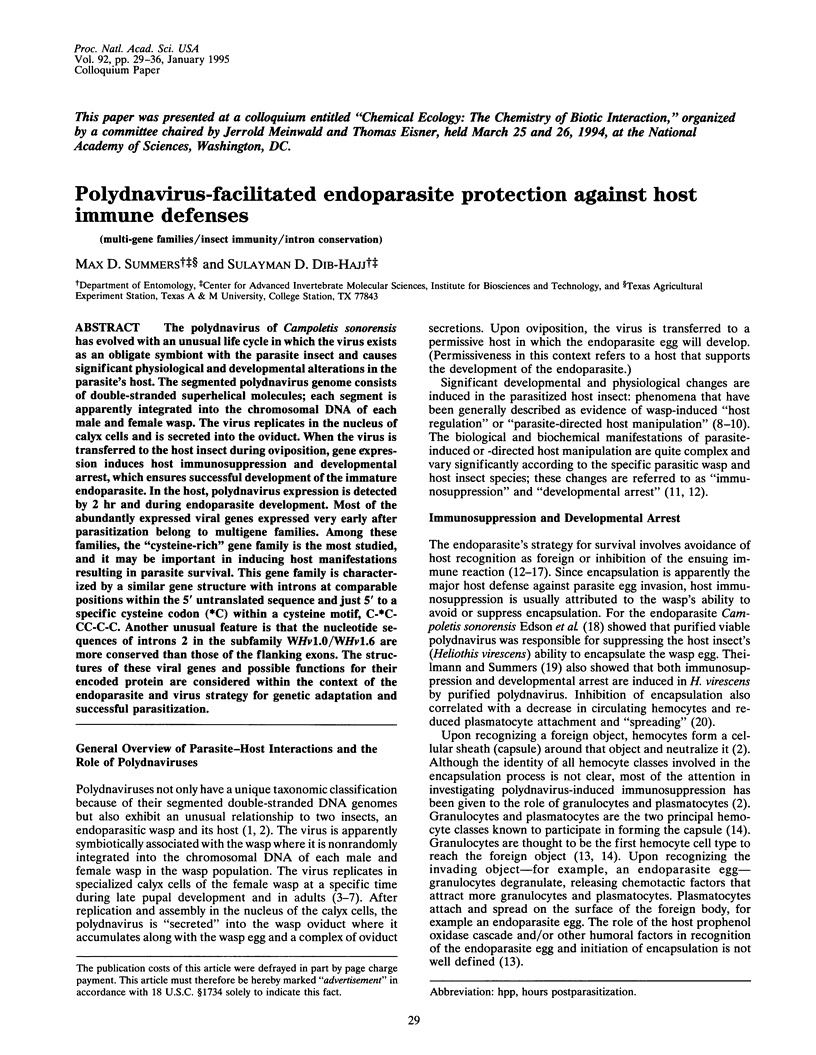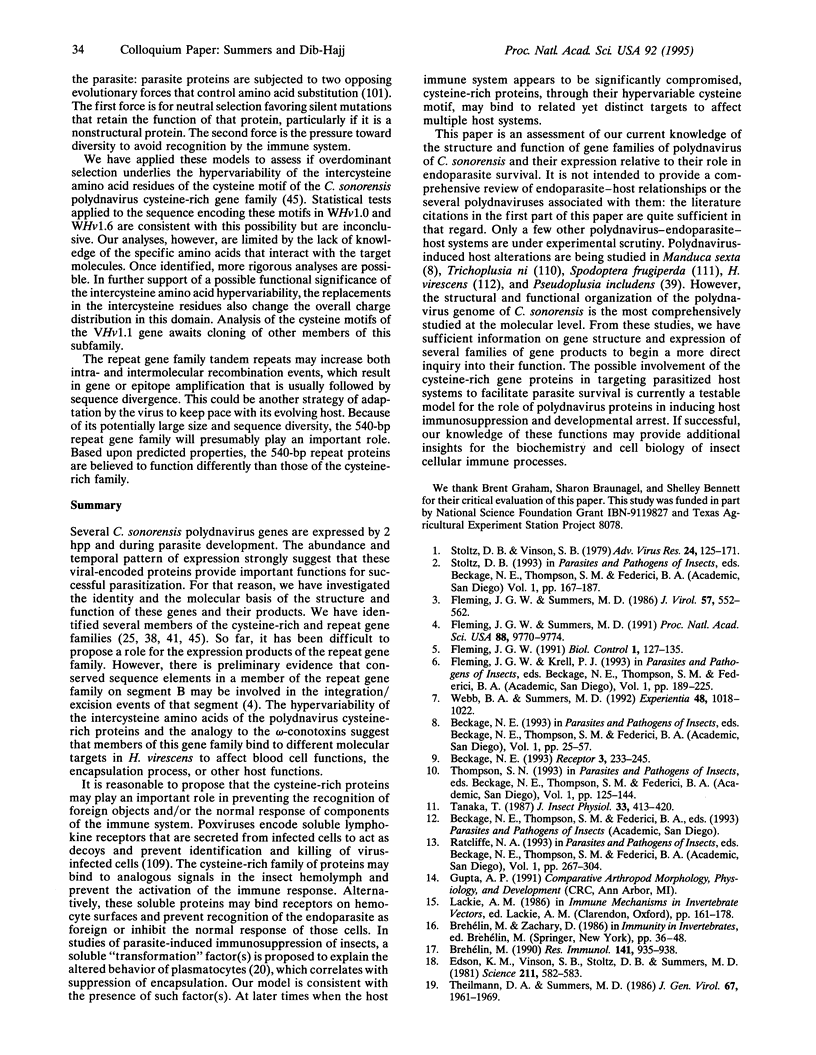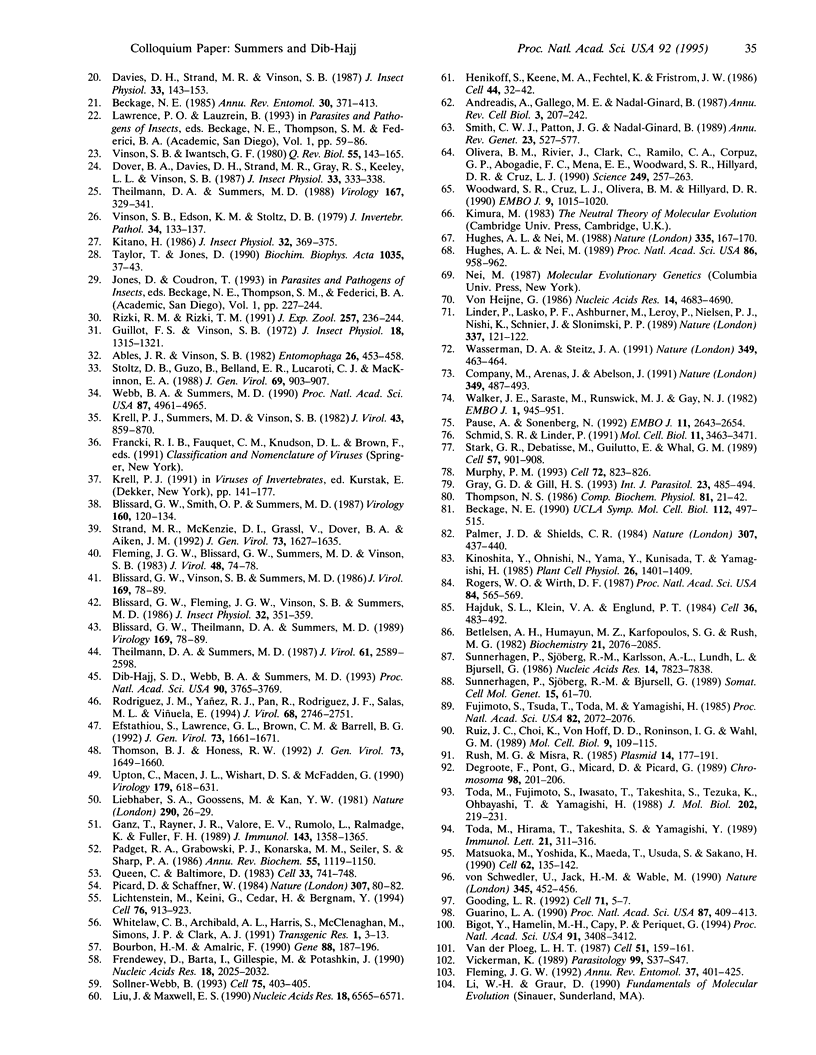Abstract
The polydnavirus of Campoletis sonorensis has evolved with an unusual life cycle in which the virus exists as an obligate symbiont with the parasite insect and causes significant physiological and developmental alterations in the parasite's host. The segmented polydnavirus genome consists of double-stranded superhelical molecules; each segment is apparently integrated into the chromosomal DNA of each male and female wasp. The virus replicates in the nucleus of calyx cells and is secreted into the oviduct. When the virus is transferred to the host insect during oviposition, gene expression induces host immunosuppression and developmental arrest, which ensures successful development of the immature endoparasite. In the host, polydnavirus expression is detected by 2 hr and during endoparasite development. Most of the abundantly expressed viral genes expressed very early after parasitization belong to multigene families. Among these families, the "cysteine-rich" gene family is the most studied, and it may be important in inducing host manifestations resulting in parasite survival. This gene family is characterized by a similar gene structure with introns at comparable positions within the 5' untranslated sequence and just 5' to a specific cysteine codon (*C) within a cysteine motif, C-*C-CC-C-C. Another unusual feature is that the nucleotide sequences of introns 2 in the subfamily WHv1.0/WHv1.6 are more conserved than those of the flanking exons. The structures of these viral genes and possible functions for their encoded protein are considered within the context of their endoparasite and virus strategy for genetic adaptation and successful parasitization.
Full text
PDF







Selected References
These references are in PubMed. This may not be the complete list of references from this article.
- Beckage N. E. Endocrine and neuroendocrine host-parasite relationships. Receptor. 1993 Fall;3(3):233–245. [PubMed] [Google Scholar]
- Bertelsen A. H., Humayun M. Z., Karfopoulos S. G., Rush M. G. Molecular characterization of small polydisperse circular deoxyribonucleic acid from an African green monkey cell line. Biochemistry. 1982 Apr 27;21(9):2076–2085. doi: 10.1021/bi00538a015. [DOI] [PubMed] [Google Scholar]
- Bigot Y., Hamelin M. H., Capy P., Periquet G. Mariner-like elements in hymenopteran species: insertion site and distribution. Proc Natl Acad Sci U S A. 1994 Apr 12;91(8):3408–3412. doi: 10.1073/pnas.91.8.3408. [DOI] [PMC free article] [PubMed] [Google Scholar]
- Blissard G. W., Smith O. P., Summers M. D. Two related viral genes are located on a single superhelical DNA segment of the multipartite Campoletis sonorensis virus genome. Virology. 1987 Sep;160(1):120–134. doi: 10.1016/0042-6822(87)90052-3. [DOI] [PubMed] [Google Scholar]
- Blissard G. W., Theilmann D. A., Summers M. D. Segment W of Campoletis sonorensis virus: expression, gene products, and organization. Virology. 1989 Mar;169(1):78–89. doi: 10.1016/0042-6822(89)90043-3. [DOI] [PubMed] [Google Scholar]
- Bourbon H. M., Amalric F. Nucleolin gene organization in rodents: highly conserved sequences within three of the 13 introns. Gene. 1990 Apr 16;88(2):187–196. doi: 10.1016/0378-1119(90)90031-l. [DOI] [PubMed] [Google Scholar]
- Brehélin M. Depression of immune reactions in insects. Res Immunol. 1990 Nov-Dec;141(9):935–938. doi: 10.1016/0923-2494(90)90197-7. [DOI] [PubMed] [Google Scholar]
- Company M., Arenas J., Abelson J. Requirement of the RNA helicase-like protein PRP22 for release of messenger RNA from spliceosomes. Nature. 1991 Feb 7;349(6309):487–493. doi: 10.1038/349487a0. [DOI] [PubMed] [Google Scholar]
- Degroote F., Pont G., Micard D., Picard G. Extrachromosomal circular DNAs in Drosophila melanogaster: comparison between embryos and Kc0% cells. Chromosoma. 1989 Sep;98(3):201–206. doi: 10.1007/BF00329684. [DOI] [PubMed] [Google Scholar]
- Dib-Hajj S. D., Webb B. A., Summers M. D. Structure and evolutionary implications of a "cysteine-rich" Campoletis sonorensis polydnavirus gene family. Proc Natl Acad Sci U S A. 1993 Apr 15;90(8):3765–3769. doi: 10.1073/pnas.90.8.3765. [DOI] [PMC free article] [PubMed] [Google Scholar]
- Edson K. M., Vinson S. B., Stoltz D. B., Summers M. D. Virus in a parasitoid wasp: suppression of the cellular immune response in the parasitoid's host. Science. 1981 Feb 6;211(4482):582–583. doi: 10.1126/science.7455695. [DOI] [PubMed] [Google Scholar]
- Efstathiou S., Lawrence G. L., Brown C. M., Barrell B. G. Identification of homologues to the human cytomegalovirus US22 gene family in human herpesvirus 6. J Gen Virol. 1992 Jul;73(Pt 7):1661–1671. doi: 10.1099/0022-1317-73-7-1661. [DOI] [PubMed] [Google Scholar]
- Fitch W. M., Leiter J. M., Li X. Q., Palese P. Positive Darwinian evolution in human influenza A viruses. Proc Natl Acad Sci U S A. 1991 May 15;88(10):4270–4274. doi: 10.1073/pnas.88.10.4270. [DOI] [PMC free article] [PubMed] [Google Scholar]
- Fleming J. A., Blissard G. W., Summers M. D., Vinson S. B. Expression of Campoletis sonorensis Virus in the Parasitized Host, Heliothis virescens. J Virol. 1983 Oct;48(1):74–78. doi: 10.1128/jvi.48.1.74-78.1983. [DOI] [PMC free article] [PubMed] [Google Scholar]
- Fleming J. A. Polydnaviruses: mutualists and pathogens. Annu Rev Entomol. 1992;37:401–425. doi: 10.1146/annurev.en.37.010192.002153. [DOI] [PubMed] [Google Scholar]
- Fleming J. A., Summers M. D. Campoletis sonorensis Endoparasitic Wasps Contain Forms of C. sonorensis Virus DNA Suggestive of Integrated and Extrachromosomal Polydnavirus DNAs. J Virol. 1986 Feb;57(2):552–562. doi: 10.1128/jvi.57.2.552-562.1986. [DOI] [PMC free article] [PubMed] [Google Scholar]
- Fleming J. G., Summers M. D. Polydnavirus DNA is integrated in the DNA of its parasitoid wasp host. Proc Natl Acad Sci U S A. 1991 Nov 1;88(21):9770–9774. doi: 10.1073/pnas.88.21.9770. [DOI] [PMC free article] [PubMed] [Google Scholar]
- Frendewey D., Barta I., Gillespie M., Potashkin J. Schizosaccharomyces U6 genes have a sequence within their introns that matches the B box consensus of tRNA internal promoters. Nucleic Acids Res. 1990 Apr 25;18(8):2025–2032. doi: 10.1093/nar/18.8.2025. [DOI] [PMC free article] [PubMed] [Google Scholar]
- Fujimoto S., Tsuda T., Toda M., Yamagishi H. Transposon-like sequences in extrachromosomal circular DNA from mouse thymocytes. Proc Natl Acad Sci U S A. 1985 Apr;82(7):2072–2076. doi: 10.1073/pnas.82.7.2072. [DOI] [PMC free article] [PubMed] [Google Scholar]
- Ganz T., Rayner J. R., Valore E. V., Tumolo A., Talmadge K., Fuller F. The structure of the rabbit macrophage defensin genes and their organ-specific expression. J Immunol. 1989 Aug 15;143(4):1358–1365. [PubMed] [Google Scholar]
- Gooding L. R. Virus proteins that counteract host immune defenses. Cell. 1992 Oct 2;71(1):5–7. doi: 10.1016/0092-8674(92)90259-f. [DOI] [PubMed] [Google Scholar]
- Gray G. D., Gill H. S. Host genes, parasites and parasitic infections. Int J Parasitol. 1993 Jul;23(4):485–494. doi: 10.1016/0020-7519(93)90037-y. [DOI] [PubMed] [Google Scholar]
- Guarino L. A. Identification of a viral gene encoding a ubiquitin-like protein. Proc Natl Acad Sci U S A. 1990 Jan;87(1):409–413. doi: 10.1073/pnas.87.1.409. [DOI] [PMC free article] [PubMed] [Google Scholar]
- Hajduk S. L., Klein V. A., Englund P. T. Replication of kinetoplast DNA maxicircles. Cell. 1984 Feb;36(2):483–492. doi: 10.1016/0092-8674(84)90241-1. [DOI] [PubMed] [Google Scholar]
- Hughes A. L. Circumsporozoite protein genes of malaria parasites (Plasmodium spp.): evidence for positive selection on immunogenic regions. Genetics. 1991 Feb;127(2):345–353. doi: 10.1093/genetics/127.2.345. [DOI] [PMC free article] [PubMed] [Google Scholar]
- Hughes A. L. Conserved proteins as immunogens: glutathione S-transferase of Schistosoma. Parasitol Today. 1994 Apr;10(4):149–151. doi: 10.1016/0169-4758(94)90266-6. [DOI] [PubMed] [Google Scholar]
- Hughes A. L., Nei M. Nucleotide substitution at major histocompatibility complex class II loci: evidence for overdominant selection. Proc Natl Acad Sci U S A. 1989 Feb;86(3):958–962. doi: 10.1073/pnas.86.3.958. [DOI] [PMC free article] [PubMed] [Google Scholar]
- Hughes A. L., Nei M. Pattern of nucleotide substitution at major histocompatibility complex class I loci reveals overdominant selection. Nature. 1988 Sep 8;335(6186):167–170. doi: 10.1038/335167a0. [DOI] [PubMed] [Google Scholar]
- Kitano Y., Okada N., Adachi J. TPA-induced alteration of actin organization in cultured human keratinocytes. Exp Cell Res. 1986 Dec;167(2):369–375. doi: 10.1016/0014-4827(86)90177-1. [DOI] [PubMed] [Google Scholar]
- Krell P. J., Summers M. D., Vinson S. B. Virus with a Multipartite Superhelical DNA Genome from the Ichneumonid Parasitoid Campoletis sonorensis. J Virol. 1982 Sep;43(3):859–870. doi: 10.1128/jvi.43.3.859-870.1982. [DOI] [PMC free article] [PubMed] [Google Scholar]
- Lichtenstein M., Keini G., Cedar H., Bergman Y. B cell-specific demethylation: a novel role for the intronic kappa chain enhancer sequence. Cell. 1994 Mar 11;76(5):913–923. doi: 10.1016/0092-8674(94)90365-4. [DOI] [PubMed] [Google Scholar]
- Liebhaber S. A., Goossens M., Kan Y. W. Homology and concerted evolution at the alpha 1 and alpha 2 loci of human alpha-globin. Nature. 1981 Mar 5;290(5801):26–29. doi: 10.1038/290026a0. [DOI] [PubMed] [Google Scholar]
- Linder P., Lasko P. F., Ashburner M., Leroy P., Nielsen P. J., Nishi K., Schnier J., Slonimski P. P. Birth of the D-E-A-D box. Nature. 1989 Jan 12;337(6203):121–122. doi: 10.1038/337121a0. [DOI] [PubMed] [Google Scholar]
- Liu J., Maxwell E. S. Mouse U14 snRNA is encoded in an intron of the mouse cognate hsc70 heat shock gene. Nucleic Acids Res. 1990 Nov 25;18(22):6565–6571. doi: 10.1093/nar/18.22.6565. [DOI] [PMC free article] [PubMed] [Google Scholar]
- Matsuoka M., Yoshida K., Maeda T., Usuda S., Sakano H. Switch circular DNA formed in cytokine-treated mouse splenocytes: evidence for intramolecular DNA deletion in immunoglobulin class switching. Cell. 1990 Jul 13;62(1):135–142. doi: 10.1016/0092-8674(90)90247-c. [DOI] [PubMed] [Google Scholar]
- Murphy P. M. Molecular mimicry and the generation of host defense protein diversity. Cell. 1993 Mar 26;72(6):823–826. doi: 10.1016/0092-8674(93)90571-7. [DOI] [PubMed] [Google Scholar]
- Olivera B. M., Rivier J., Clark C., Ramilo C. A., Corpuz G. P., Abogadie F. C., Mena E. E., Woodward S. R., Hillyard D. R., Cruz L. J. Diversity of Conus neuropeptides. Science. 1990 Jul 20;249(4966):257–263. doi: 10.1126/science.2165278. [DOI] [PubMed] [Google Scholar]
- Padgett R. A., Grabowski P. J., Konarska M. M., Seiler S., Sharp P. A. Splicing of messenger RNA precursors. Annu Rev Biochem. 1986;55:1119–1150. doi: 10.1146/annurev.bi.55.070186.005351. [DOI] [PubMed] [Google Scholar]
- Pause A., Sonenberg N. Mutational analysis of a DEAD box RNA helicase: the mammalian translation initiation factor eIF-4A. EMBO J. 1992 Jul;11(7):2643–2654. doi: 10.1002/j.1460-2075.1992.tb05330.x. [DOI] [PMC free article] [PubMed] [Google Scholar]
- Picard D., Schaffner W. A lymphocyte-specific enhancer in the mouse immunoglobulin kappa gene. Nature. 1984 Jan 5;307(5946):80–82. doi: 10.1038/307080a0. [DOI] [PubMed] [Google Scholar]
- Queen C., Baltimore D. Immunoglobulin gene transcription is activated by downstream sequence elements. Cell. 1983 Jul;33(3):741–748. doi: 10.1016/0092-8674(83)90016-8. [DOI] [PubMed] [Google Scholar]
- Rizki R. M., Rizki T. M. Effects of lamellolysin from a parasitoid wasp on Drosophila blood cells in vitro. J Exp Zool. 1991 Feb;257(2):236–244. doi: 10.1002/jez.1402570214. [DOI] [PubMed] [Google Scholar]
- Rodriguez J. M., Yañez R. J., Pan R., Rodriguez J. F., Salas M. L., Viñuela E. Multigene families in African swine fever virus: family 505. J Virol. 1994 Apr;68(4):2746–2751. doi: 10.1128/jvi.68.4.2746-2751.1994. [DOI] [PMC free article] [PubMed] [Google Scholar]
- Rogers W. O., Wirth D. F. Kinetoplast DNA minicircles: regions of extensive sequence divergence. Proc Natl Acad Sci U S A. 1987 Jan;84(2):565–569. doi: 10.1073/pnas.84.2.565. [DOI] [PMC free article] [PubMed] [Google Scholar]
- Ruiz J. C., Choi K. H., von Hoff D. D., Roninson I. B., Wahl G. M. Autonomously replicating episomes contain mdr1 genes in a multidrug-resistant human cell line. Mol Cell Biol. 1989 Jan;9(1):109–115. doi: 10.1128/mcb.9.1.109. [DOI] [PMC free article] [PubMed] [Google Scholar]
- Rush M. G., Misra R. Extrachromosomal DNA in eucaryotes. Plasmid. 1985 Nov;14(3):177–191. doi: 10.1016/0147-619x(85)90001-0. [DOI] [PubMed] [Google Scholar]
- Schmid S. R., Linder P. Translation initiation factor 4A from Saccharomyces cerevisiae: analysis of residues conserved in the D-E-A-D family of RNA helicases. Mol Cell Biol. 1991 Jul;11(7):3463–3471. doi: 10.1128/mcb.11.7.3463. [DOI] [PMC free article] [PubMed] [Google Scholar]
- Smith C. W., Patton J. G., Nadal-Ginard B. Alternative splicing in the control of gene expression. Annu Rev Genet. 1989;23:527–577. doi: 10.1146/annurev.ge.23.120189.002523. [DOI] [PubMed] [Google Scholar]
- Smith G. L. Vaccinia virus glycoproteins and immune evasion. The sixteenth Fleming Lecture. J Gen Virol. 1993 Sep;74(Pt 9):1725–1740. doi: 10.1099/0022-1317-74-9-1725. [DOI] [PubMed] [Google Scholar]
- Soldevila A. I., Jones D. Characterization of a novel protein associated with the parasitization of lepidopteran hosts by an endoparasitic wasp. Insect Biochem Mol Biol. 1994 Jan;24(1):29–38. doi: 10.1016/0965-1748(94)90120-1. [DOI] [PubMed] [Google Scholar]
- Sollner-Webb B. Novel intron-encoded small nucleolar RNAs. Cell. 1993 Nov 5;75(3):403–405. doi: 10.1016/0092-8674(93)90374-y. [DOI] [PubMed] [Google Scholar]
- Stark G. R., Debatisse M., Giulotto E., Wahl G. M. Recent progress in understanding mechanisms of mammalian DNA amplification. Cell. 1989 Jun 16;57(6):901–908. doi: 10.1016/0092-8674(89)90328-0. [DOI] [PubMed] [Google Scholar]
- Stoltz D. B., Vinson S. B. Viruses and parasitism in insects. Adv Virus Res. 1979;24:125–171. doi: 10.1016/s0065-3527(08)60393-0. [DOI] [PubMed] [Google Scholar]
- Strand M. R., McKenzie D. I., Grassl V., Dover B. A., Aiken J. M. Persistence and expression of Microplitis demolitor polydnavirus in Pseudoplusia includens. J Gen Virol. 1992 Jul;73(Pt 7):1627–1635. doi: 10.1099/0022-1317-73-7-1627. [DOI] [PubMed] [Google Scholar]
- Sunnerhagen P., Sjöberg R. M., Bjursell G. Increase of extrachromosomal circular DNA in mouse 3T6 cells on perturbation of DNA synthesis: implications for gene amplification. Somat Cell Mol Genet. 1989 Jan;15(1):61–70. doi: 10.1007/BF01534670. [DOI] [PubMed] [Google Scholar]
- Sunnerhagen P., Sjöberg R. M., Karlsson A. L., Lundh L., Bjursell G. Molecular cloning and characterization of small polydisperse circular DNA from mouse 3T6 cells. Nucleic Acids Res. 1986 Oct 24;14(20):7823–7838. doi: 10.1093/nar/14.20.7823. [DOI] [PMC free article] [PubMed] [Google Scholar]
- Tanaka T., Nei M. Positive darwinian selection observed at the variable-region genes of immunoglobulins. Mol Biol Evol. 1989 Sep;6(5):447–459. doi: 10.1093/oxfordjournals.molbev.a040569. [DOI] [PubMed] [Google Scholar]
- Taylor T., Jones D. Isolation and characterization of the 32.5 kDa protein from the venom of an endoparasitic wasp. Biochim Biophys Acta. 1990 Jul 20;1035(1):37–43. doi: 10.1016/0304-4165(90)90170-2. [DOI] [PubMed] [Google Scholar]
- Theilmann D. A., Summers M. D. Identification and comparison of Campoletis sonorensis virus transcripts expressed from four genomic segments in the insect hosts Campoletis sonorensis and Heliothis virescens. Virology. 1988 Dec;167(2):329–341. [PubMed] [Google Scholar]
- Theilmann D. A., Summers M. D. Molecular analysis of Campoletis sonorensis virus DNA in the lepidopteran host Heliothis virescens. J Gen Virol. 1986 Sep;67(Pt 9):1961–1969. doi: 10.1099/0022-1317-67-9-1961. [DOI] [PubMed] [Google Scholar]
- Theilmann D. A., Summers M. D. Physical Analysis of the Campoletis sonorensis Virus Multipartite Genome and Identification of a Family of Tandemly Repeated Elements. J Virol. 1987 Aug;61(8):2589–2598. doi: 10.1128/jvi.61.8.2589-2598.1987. [DOI] [PMC free article] [PubMed] [Google Scholar]
- Thompson S. N. Metabolic integration during the host associations of multicellular animal endoparasites. Comp Biochem Physiol B. 1985;81(1):21–42. doi: 10.1016/0305-0491(85)90157-9. [DOI] [PubMed] [Google Scholar]
- Thomson B. J., Honess R. W. The right end of the unique region of the genome of human herpesvirus 6 U1102 contains a candidate immediate early gene enhancer and a homologue of the human cytomegalovirus US22 gene family. J Gen Virol. 1992 Jul;73(Pt 7):1649–1660. doi: 10.1099/0022-1317-73-7-1649. [DOI] [PubMed] [Google Scholar]
- Toda M., Fujimoto S., Iwasato T., Takeshita S., Tezuka K., Ohbayashi T., Yamagishi H. Structure of extrachromosomal circular DNAs excised from T-cell antigen receptor alpha and delta-chain loci. J Mol Biol. 1988 Jul 20;202(2):219–231. doi: 10.1016/0022-2836(88)90453-6. [DOI] [PubMed] [Google Scholar]
- Toda M., Hirama T., Takeshita S., Yamagishi H. Excision products of immunoglobulin gene rearrangements. Immunol Lett. 1989 Jun 15;21(4):311–316. doi: 10.1016/0165-2478(89)90025-4. [DOI] [PubMed] [Google Scholar]
- Upton C., Macen J. L., Wishart D. S., McFadden G. Myxoma virus and malignant rabbit fibroma virus encode a serpin-like protein important for virus virulence. Virology. 1990 Dec;179(2):618–631. doi: 10.1016/0042-6822(90)90129-f. [DOI] [PubMed] [Google Scholar]
- Van der Ploeg L. H. Control of variant surface antigen switching in trypanosomes. Cell. 1987 Oct 23;51(2):159–161. doi: 10.1016/0092-8674(87)90140-1. [DOI] [PubMed] [Google Scholar]
- Walker J. E., Saraste M., Runswick M. J., Gay N. J. Distantly related sequences in the alpha- and beta-subunits of ATP synthase, myosin, kinases and other ATP-requiring enzymes and a common nucleotide binding fold. EMBO J. 1982;1(8):945–951. doi: 10.1002/j.1460-2075.1982.tb01276.x. [DOI] [PMC free article] [PubMed] [Google Scholar]
- Wassarman D. A., Steitz J. A. RNA splicing. Alive with DEAD proteins. Nature. 1991 Feb 7;349(6309):463–464. doi: 10.1038/349463a0. [DOI] [PubMed] [Google Scholar]
- Webb B. A., Summers M. D. Stimulation of polydnavirus replication by 20-hydroxyecdysone. Experientia. 1992 Oct 15;48(10):1018–1022. doi: 10.1007/BF01919157. [DOI] [PubMed] [Google Scholar]
- Webb B. A., Summers M. D. Venom and viral expression products of the endoparasitic wasp Campoletis sonorensis share epitopes and related sequences. Proc Natl Acad Sci U S A. 1990 Jul;87(13):4961–4965. doi: 10.1073/pnas.87.13.4961. [DOI] [PMC free article] [PubMed] [Google Scholar]
- Whitelaw C. B., Archibald A. L., Harris S., McClenaghan M., Simons J. P., Clark A. J. Targeting expression to the mammary gland: intronic sequences can enhance the efficiency of gene expression in transgenic mice. Transgenic Res. 1991 Dec;1(1):3–13. doi: 10.1007/BF02512991. [DOI] [PubMed] [Google Scholar]
- Woodward S. R., Cruz L. J., Olivera B. M., Hillyard D. R. Constant and hypervariable regions in conotoxin propeptides. EMBO J. 1990 Apr;9(4):1015–1020. doi: 10.1002/j.1460-2075.1990.tb08204.x. [DOI] [PMC free article] [PubMed] [Google Scholar]
- von Heijne G. A new method for predicting signal sequence cleavage sites. Nucleic Acids Res. 1986 Jun 11;14(11):4683–4690. doi: 10.1093/nar/14.11.4683. [DOI] [PMC free article] [PubMed] [Google Scholar]
- von Schwedler U., Jäck H. M., Wabl M. Circular DNA is a product of the immunoglobulin class switch rearrangement. Nature. 1990 May 31;345(6274):452–456. doi: 10.1038/345452a0. [DOI] [PubMed] [Google Scholar]


